

Project Scope Management: Definition, Importance, Benefits, and How It Works

Published: May 16, 2023
Updated: June 14, 2024
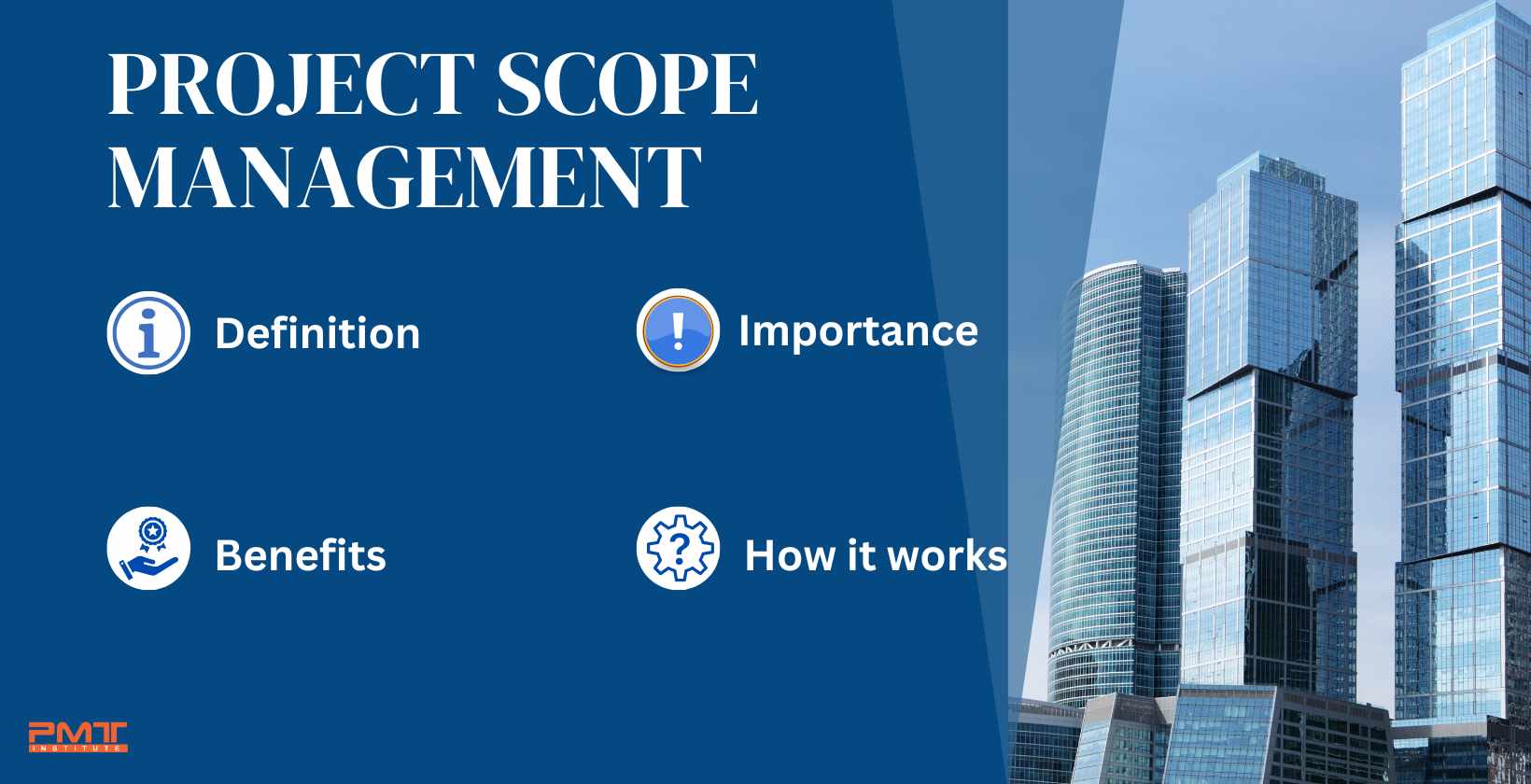
Project Scope Management encompasses the process of defining, planning, monitoring, and regulating the scope of a project. It involves identifying the scope of the project, determining the deliverables, and establishing the parameters within which the project is slated to be completed. A Project Scope Management's value rests in its facilitation of efficient management of project time, money, and resources. Scope creep occurs when a project's scope grows uncontrollably without adequate supervision, often resulting in missed deadlines, increased costs, and lower quality.
Planning, defining, verifying, and controlling the scope of a project are all essential parts of effective project scope management. The project team creates a scope management strategy after determining the project's boundaries. The team further specifies the project's scope, deliverables, and objectives during the scope definition process. The other two processes, scope verification, and scope change control, work together to guarantee that the project's final products are exactly what was promised.
The benefits of Project Scope Management consist of enhanced project planning, higher productivity, and clearer lines of communication among all parties involved. Project managers head off problems before they arise by keeping an eye on the big picture and keeping track of all the moving parts.
Table of Contents
What is Project Scope Management?
What is the importance of project scope management, how does project scope management work, what are the benefits of project scope management, what are the key processes of project scope management, what are the consequences of poor project scope management.
Misunderstandings among project team members, stakeholders, and clients are mitigated by transparent communication about project scope and objectives. A good example of such is in a software development project, where the scope covers everything from concept creation through final deployment. Hardware acquisition and infrastructure setup are outside the scope and are handled by a different group or provider.
Project Scope Management is responsible for outlining, scheduling, tracking, and closing the tasks that must be completed in order to accomplish the project's stated goals and objectives. It includes managing the requirements, deliverables, tasks, deadlines, and limitations of a project and entails tracking and responding to changes as they occur. Managing the scope of a project is essential to its success since it helps keep it within its parameters, satisfies stakeholders' needs, and finishes on schedule and on budget.
Scope management for a project is effective as it involves breaking the project down into smaller, more manageable chunks, defining the scope of work for each chunk, creating a plan for managing scope, reviewing progress against the plan, and making adjustments as needed to keep the project on track.
The importance of Project Scope Management is widely recognized in the project management community. It is a fundamental process that helps project managers to define the project objectives, determine the scope of work, and set boundaries for the project.
A study by the Project Management Institute (PMI) found that organizations with mature project management practices had a higher success rate in meeting project objectives than those with less mature practices. Moreover, organizations that utilized a formal Project Scope Management process reported a higher percentage of completed projects within budget and on time.
Another study conducted by the Standish Group found that one of the primary reasons for project failure is poor scope management. The study revealed that more than half of all project failures are due to scope-related issues, such as incomplete or poorly defined requirements, inadequate project planning, and failure to control scope creep.
Additionally, a study by the Construction Industry Institute (CII) found that effective Project Scope Management is one of the most important factors contributing to project success. The study found that successful projects had a well-defined scope, a clear scope management plan, and a system for managing changes to the project scope.
Effective Project Scope Management helps project managers to identify potential risks and address them before they become issues. Clearly defining the scope of the project and documenting it in a scope management plan help project managers ensure that all stakeholders have a clear understanding of the project objectives, deliverables, and boundaries.
Research has consistently shown that effective Project Scope Management is critical for project success. Properly defining the project scope and managing changes to it help prevent scope creep, identify and mitigate risks, support resource management, and promote better communication and stakeholder engagement.
Project Scope Management involves a number of processes that help to ensure that a project remains within its defined boundaries and satisfies stakeholder requirements. Definition of the project's scope, objectives, deliverables, and requirements is the first step in Scope Planning. It involves creating a strategy for managing the project's scope throughout the project lifecycle. The scope management plan describes how alterations to the project's scope are managed and the procedures for monitoring and controlling the project's scope.
The second process is Scope Definition, which entails elaborating on the project's objectives and scope. It involves designating the specific tasks, activities, and deliverables necessary to achieve the project's goals, as well as the project's boundaries and constraints. Scope Verification is the process of reviewing and acquiring formal acceptance of the project's scope from stakeholders to ensure that the project is meeting their expectations and requirements. Such a procedure ensures that all project participants are on the same page and that the project meets stakeholder expectations.
Scope Change Control concludes with the surveillance of the project's scope, identification of changes, and management of the changes' impact. It entails evaluating the impact of changes on the project's timeline, budget, and resources, and obtaining approval from stakeholders prior to implementing changes. The process prevents scope creep and ensures that any modifications to the project's scope are appropriately approved and managed.
Effectively managing the project's scope enables project managers to ensure that the project remains within its defined boundaries, meets the requirements and expectations of stakeholders, and meets its deadlines and budget constraints.

Effective Project Scope Management provides several benefits, including:
Clear project goals and objectives: The project's success depends on the team's ability to clearly define the project's scope and objectives. Team members are better able to grasp what is needed to complete the project successfully, and the project's efforts are better able to mesh with the larger business vision. Team members are less likely to disagree if they have a shared knowledge of the project's goals.
Better communication and collaboration: Having a defined project scope helps to ensure that all parties involved in the project have a common knowledge of its goals and expectations. Good communication and teamwork are essential to ensure the project continues on track and any challenges are resolved quickly and efficiently.
Improved project planning: A well-planned project, with clearly defined tasks and deliverables, is going to be completed on time and within budget thanks to careful Scope Management. It lessens the likelihood of costly delays or overruns and keeps the project on track. Early detection and resolution of problems are facilitated by thorough planning.
Efficient use of resources: Project managers are better able to determine what people, machines, and supplies are going to be required to carry out a project if its scope and requirements are clearly defined. Managing project scope effectively allows project managers to avoid unnecessary work, which helps reduce costs and improve project efficiency.
Minimizing project risks: The sooner risks and issues are identified in the project lifecycle, the sooner they are able to be mitigated and contingency plans are developed. Overall project outcomes are enhanced as risks are mitigated and issues are avoided.
Improved stakeholder satisfaction: Project managers are able to guarantee that their work is going to satisfy stakeholders if they handle scope management seriously. Stakeholders are more likely to be pleased with the final product when they see that their concerns were taken into account and handled.
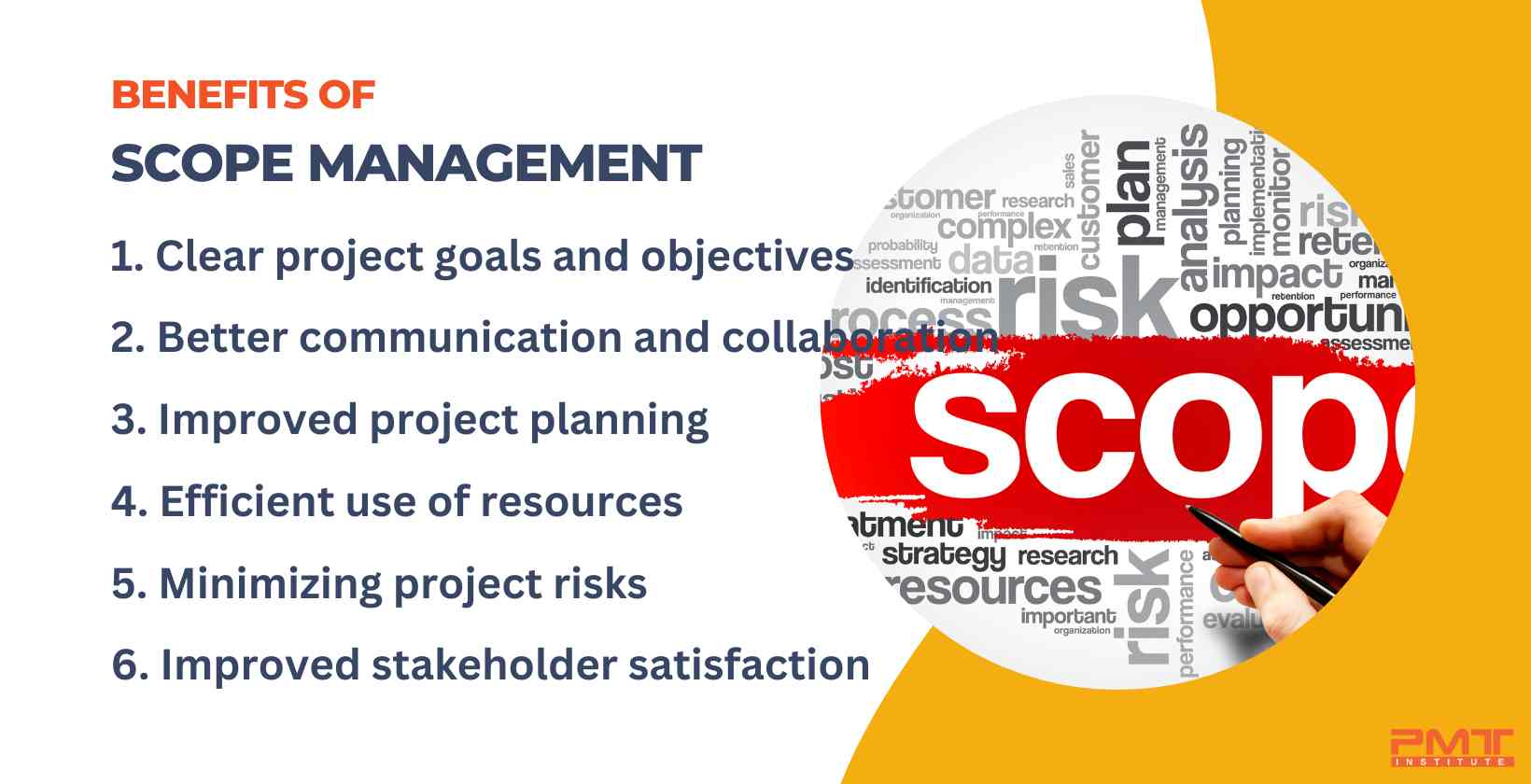
Effective Project Scope Management is critical for project success. It helps to ensure that the project stays on track and meets stakeholder expectations, while promoting effective communication and collaboration, improving project planning and resource allocation, minimizing risks, and improving stakeholder satisfaction at the same time.
Who is in charge of determining the Scope and Management of the Project?
The project manager is responsible for setting the project's goals and overseeing its execution. Project managers must oversee the scope of the project at all times, which involves adhering to the project management process detailed in the field of Project Scope Management. The first step in managing the project's scope is the creation of a Scope Management Plan by the project manager. A project's scope, objectives, and needs, as well as the mechanisms for monitoring and controlling those factors, are all laid out in such a plan.
The project manager then refines the scope by detailing the steps and deliverables that must be completed in order to reach the project's goals. The assumptions made during the planning phase, as well as the project's limits and scope, are highlighted as well. The project manager formally accepts the project scope after evaluating it with everyone involved to make sure the project is living up to everyone's expectations and needs.
The project manager's role is to keep an eye on the project's scope, keep track of any changes, and deal with the fallout from any alterations. Changes must be evaluated for their potential effect on the project's timeline, money, and resources, and stakeholders must be consulted and approved before any action is taken. The project manager's responsibility is to keep the project on schedule and in line with stakeholder expectations through careful management of the project's scope.
What is the Role of Stakeholders in Project Scope Management?
Stakeholders play a vital role in Project Scope Management. Stakeholders are individuals or groups that have a vested interest in the project and its outcomes. The project manager works closely with stakeholders throughout the project lifecycle to ensure that the project scope is well-defined and aligned with stakeholder needs.
Stakeholders provide input on the project scope, objectives, and requirements, helping to ensure that they are well-defined and meet their expectations. They review and provide formal acceptance of the project scope, ensuring that the project is meeting their expectations and requirements.
Additionally, stakeholders are able to identify changes that need to be made to the project scope and must approve any changes before they are implemented. Effective stakeholder management is crucial for the success of project scope management. The project manager must engage with stakeholders throughout the project lifecycle to make sure that their needs are understood, and that they are informed about the changes to the project scope. Doing so helps ensure that the project stays on track and meets stakeholder expectations. Working closely with stakeholders allows project managers to achieve a successful project outcome.
The key processes of project scope management are:
Scope Planning: It involves defining the project scope, objectives, deliverables, and requirements, and developing a plan for how the project scope is managed throughout the project lifecycle. The scope management plan outlines how changes to the project scope are handled and the processes for monitoring and controlling the project scope.
Scope Definition: It involves further detailing the project scope and requirements, and identifying the boundaries and limitations of the project. Scope Definition includes identifying the specific tasks, activities, and deliverables required to achieve the project objectives.
Create WBS: It involves breaking down the project scope into smaller, more manageable pieces, called work packages. The work packages are then organized into a hierarchical structure called the Work Breakdown Structure (WBS).
Scope Verification: It involves reviewing and obtaining formal acceptance of the project scope from stakeholders to ensure that the project is meeting their expectations and requirements.
Scope Change Control: It involves monitoring the project scope, identifying changes, and managing the impact of those changes on the project. Scope Change Control includes assessing the impact of changes on the project schedule, budget, and resources and obtaining approval from stakeholders before implementing changes.
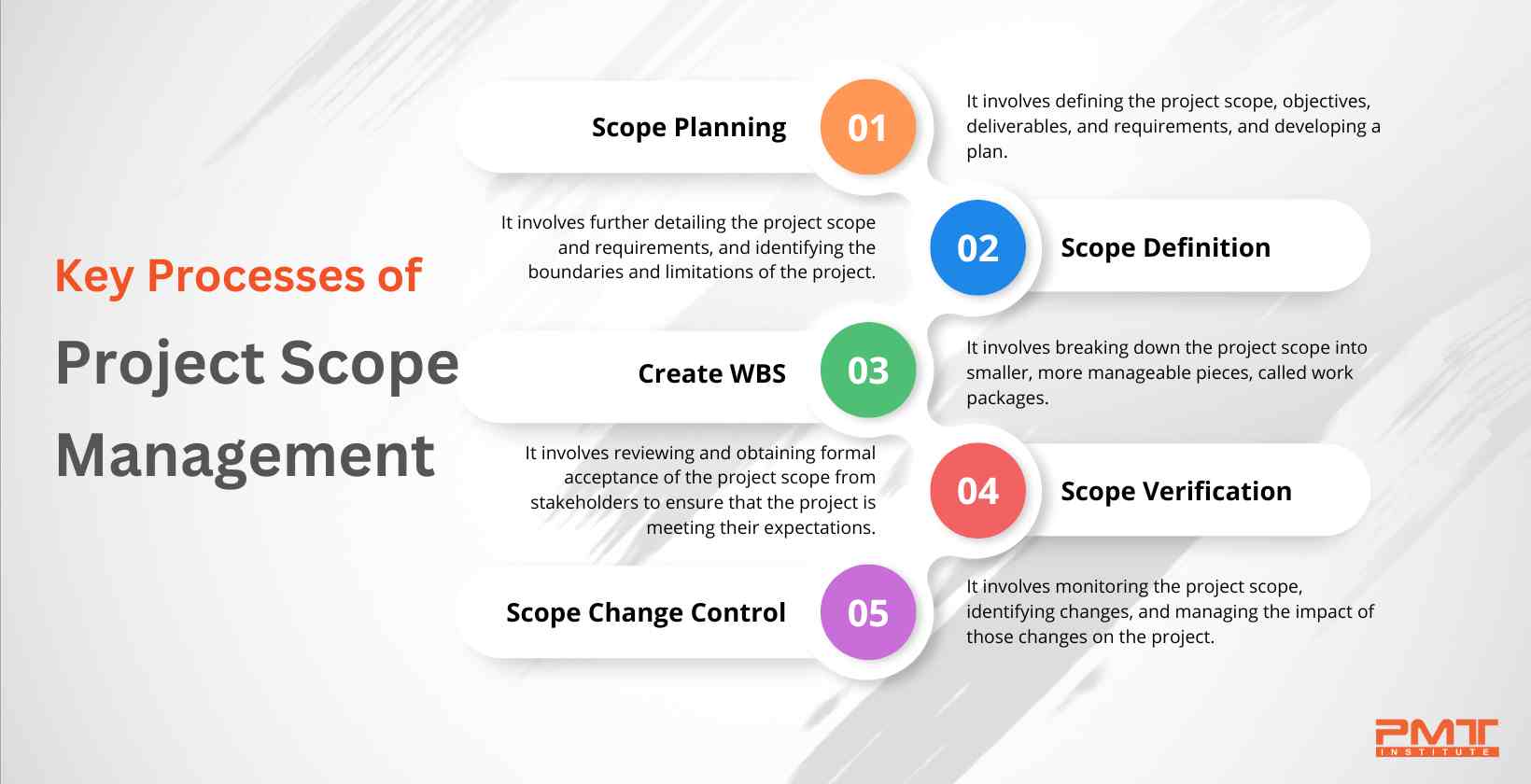
These processes are interrelated and built upon each other to ensure that the project scope is well-defined, managed, and controlled throughout the project lifecycle. Following these processes allows the project team to ensure that the project meets stakeholder expectations, stays on track, and is completed on time and within budget.
How Do Project Managers Communicate the Project Scope Effectively?
Project managers use a variety of strategies to communicate the project scope effectively. Developing a scope statement is a crucial step in any successful plan. A project's scope statement is a written description of the project's intended outcomes, activities, and deliverables. The scope declaration needs to be written in simple, straightforward language. To make sure everyone is on the same page, it needs to be reviewed and approved by everyone involved in the project before work begins.
Making a WBS is a useful method as well. A Work Breakdown Structure (WBS) is a graphical depiction of the project's scope that helps break it down into more manageable chunks. The Work Breakdown Structure (WBS) explains the organization of the project and how each part fits into the bigger picture. Additionally, holding regular meetings with stakeholders is crucial for conveying the project's scope clearly. These meetings provide the project manager an opportunity to update stakeholders on the status of the project, address any concerns or issues, and keep everyone involved in the loop as the project develops.
One of the most effective methods of keeping stakeholders in the loop is by regularly updating them on progress. These reports provide an overview of the project's goals, milestones, and any subsequent adjustments. They clarify for those involved the state of the project and any alterations that have been made. Communicating the scope of a project effectively is additionally enhanced by the use of visuals like charts, graphs, and diagrams. These tools make it much simpler to comprehend otherwise difficult material.
All in all, it's crucial for project success to have clear and consistent communication about the scope of the work being done. Project managers have the ability to increase the likelihood that their projects are going to be completed on time, under budget, and to the satisfaction of all parties involved by emphasizing the importance of clear communication and the use of visual aids.
How Do Project Managers Ensure the Project Scope is Aligned with the Objectives?
It is essential for a project's success that the scope of the project matches its goals. Managers of projects need to have a firm grasp on the project's intended outcomes, which they must then convey clearly to all parties involved. Doing so makes it more likely that everyone involved in the project has the same expectations.
Project stakeholders must help craft the project scope statement to ensure it adequately captures the scope of work to be accomplished. To make the project more manageable, a work breakdown structure (WBS) is developed. It is a graphical depiction of the entire project's scope.
The project manager is responsible for keeping the project's scope up to date and in line with the project's goals at all times. It is important to consider how a shift in the project's scope affects the end goal and revise the project plan accordingly.
Project managers must establish and convey to all stakeholders precise methods for scope management in order to monitor and regulate the project's scope. It includes articulating a process for handling changes to the project's scope and making sure everyone involved understands how such alterations impact the project's schedule, budget, and resources.
Project success and stakeholder satisfaction are ensured if managers follow these measures to guarantee that the project scope is in line with the project objectives. Achieving such alignment is essential for successfully completing a project on time, within budget, and to the satisfaction of all stakeholders.
How Do Project Managers Identify and Manage Scope Creep in Projects?
The term "scope creep" is used to describe when a project's scope grows beyond its initial goals and objectives without enough planning or planning permission. Significant time and money waste, as well as compromised quality, lead to such issues. The project manager is largely responsible for controlling scope creep. They are in charge of evaluating and managing any modifications to the project's scope to ensure that it remains aligned with the project's goals and objectives.
Managers of such projects must employ a variety of tactics for dealing with scope creep. The first step in each project is to create a detailed scope statement that specifies the project's aims, methods, outputs, and schedule. Additionally, project managers must set up a rigorous change control procedure to monitor and handle any and all alterations to the project's original scope. The sponsor or stakeholders have to review and approve any proposed changes to the project's scope before proceeding with a project.
Project managers need to make sure the project scope is still in line with the original project objectives on a frequent basis as well. The time, money, and manpower that are required to implement a scope modification must be considered. Project managers have to inform all parties involved of any changes and how they are likely to affect the project's schedule, money, and resources. Moreover, such measures aid in controlling stakeholder expectations and preventing unnecessary expansion of the project's scope.
Managers are obliged to keep an eye on the project's development for signs of scope creep. The effects on the project's schedule, money, and resources must be documented and assessed after any deviations have occurred. The project manager needs to take corrective action to keep the project scope under control if necessary. Some examples include making adjustments to the project's scope, schedule, or priority. Scope creep has a significant negative influence on a project's scheduling, budget, and resources if not properly identified and managed.

Poor project scope management leads to various consequences, including:
Project delays: Poor scope management results in changes to the project scope that delay project completion. The project is likely to suffer from rework, as the team has to redo work that was not included in the original scope.
Increased project costs: Changes to the project scope leads to increased project costs, as the team requires additional resources to complete the project. These additional costs have not been accounted for in the project budget, leading to budget overruns.
Poor quality deliverables: A project scope that is not clearly defined or changes frequently leads to poor quality deliverables. It's because the team does not have a clear understanding of what is expected of them, or they rush to complete the project to meet changing deadlines.
Dissatisfied stakeholders: Poor project scope management results in dissatisfied stakeholders, as the project failed to meet their expectations or requirements. Such consequences cause strained relationships and damage to the project manager's reputation.
Reduced team morale: Frequent changes to the project scope result in confusion and frustration among the project team and reduces morale and productivity.
Project scope management must be given priority to mitigate these consequences. Project managers must ensure that the project scope is clearly defined, communicated, and understood by all stakeholders to mitigate these consequences.
Such is achieved by developing a scope management plan, setting clear project objectives and deliverables, establishing a formal change control process, regularly reviewing project scope, and communicating any changes to stakeholders. Additionally, regular project status updates and stakeholder engagement helps ensure that all stakeholders are aligned with project objectives and expectations.
What Are the Best Practices for Managing Project Scope Changes?
Managing project scope changes is a challenging task for any project manager. Listed below are some best practices that help:
Have a clear scope baseline: Project managers must ensure that they have a clear and agreed-upon scope baseline at the start of the project, including the project objectives, deliverables, timelines, and budget.
Develop a change control process: Develop a formal change control process that outlines how scope changes are identified, evaluated, and approved or rejected. The process must define how changes are communicated to the project team and stakeholders.
Document all changes: Document all scope changes, including the reason for the change, the impact on the project timeline, budget, and deliverables, and the approval process.
Assess the impact of the change: Evaluate the impact of the change on the project's objectives, timeline, budget, and resources. Identify any risks and dependencies that are likely affected by the change.
Get approval from stakeholders: Obtain approval from all stakeholders, including the project sponsor and the project team, before implementing any scope changes. Doing so helps ensure that everyone is aware of the changes and their impact.
Communicate the changes: Communicate any scope changes to the project team, stakeholders, and any other relevant parties, which include the impact of the change and any revised timelines or budget.
Monitor and control changes: Monitor and control any scope changes to ensure that they do not have a negative impact on the project's objectives, timeline, budget, or quality.
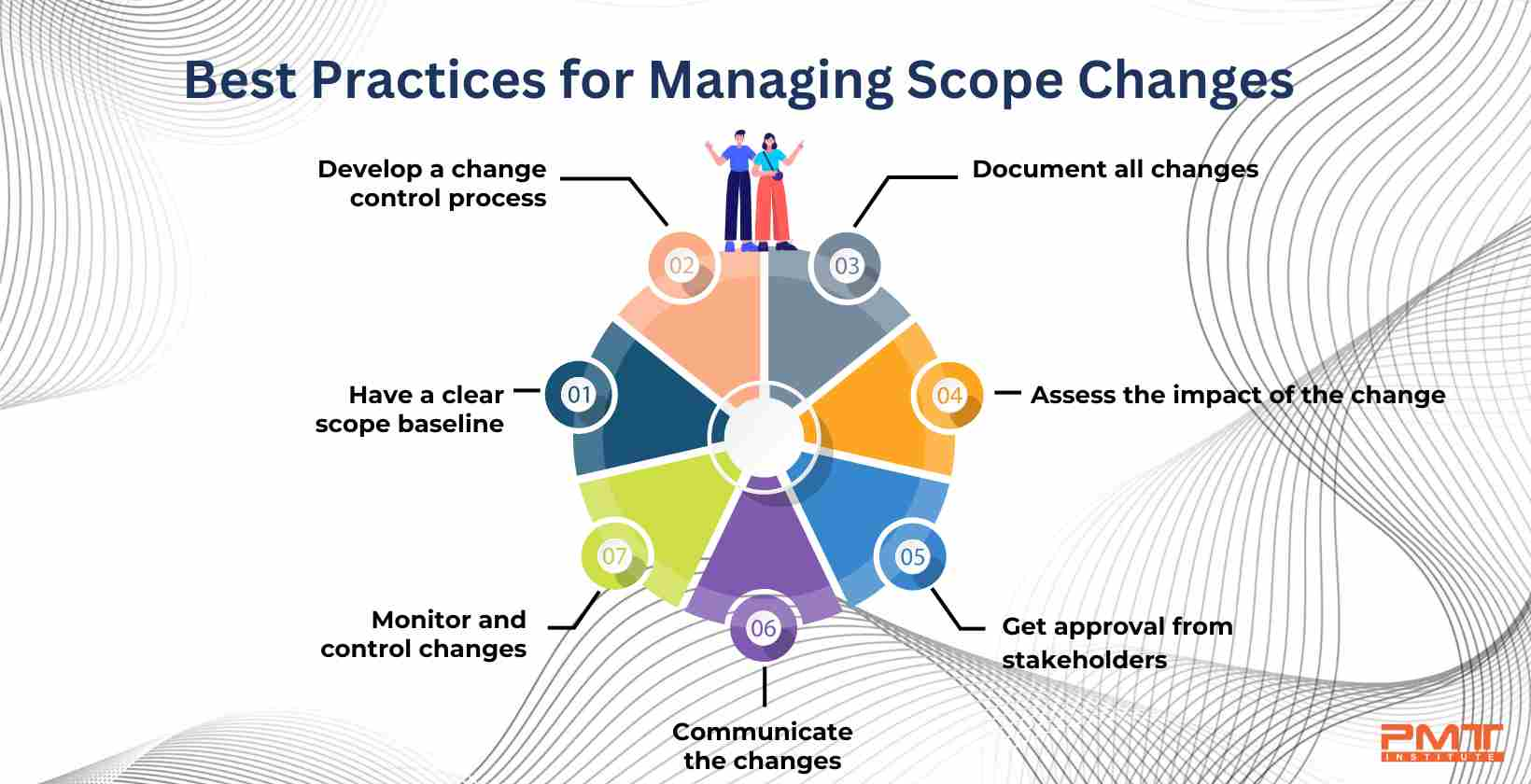
Following these practices aids project managers in effectively managing scope changes and ensuring that the project stays on track.
Is the Project Scope Management Part of the Project Planning Process?
Yes, project scope management is an integral aspect of any successful project strategy. The Project Management Institute (PMI) includes it as a core competency in their Project Management Body of Knowledge (PMBOK) Guide. The project's goals, deliverables, and requirements, as well as a plan for how the project's scope is maintained throughout the project's lifecycle, must all be defined as part of the scope management process.
Common components of a scope management plan are the scope statement, scope baseline, and methods for managing changes to the scope. A well-defined scope management strategy helps project managers keep their projects on schedule and on target.
Do the Project Managers Manage Project Scope Management?
Yes, project managers are responsible for managing project scope management. It is one of the primary responsibilities of a project manager to ensure that the project stays within the defined scope, meets the objectives, and delivers the expected outcomes. Project managers must ensure that the project's scope is well-defined and that it aligns with the stakeholders' expectations. They must manage any changes to the project's scope to prevent scope creep and ensure that any changes are evaluated and approved before implementation as well.
Project managers must have a clear understanding of the project's scope, including its objectives, deliverables, and requirements, and develop a scope management plan that outlines how the scope is managed throughout the project's lifecycle. They have to monitor and control the scope throughout the project to ensure that it stays on track and aligns with the project's objectives. Therefore, it is the project manager's responsibility to effectively manage the project scope management.
Is Project Scope Management Necessary for the Project?
Yes, project scope management is essential to a project's success. It's a useful tool for making sure the project stays on track and accomplishes its goals. A project's scope is likely to expand beyond its initial goals, causing delays, budget overruns, and dissatisfied stakeholders without proper scope management.
Project managers ensure that all team members are on the same page with regard to the project's intended outcomes and deliverables through effective scope management. Doing so improves the project's chances of success by bringing it in line with the hopes of those who are going to be affected by it.
Moreover, good scope management aids in the proactive management of project risks by identifying and controlling prospective modifications to the project's scope. The framework ensures that changes are assessed for their potential effect on the project's schedule, money, and goals, and that approval is granted only after all relevant factors have been considered. Therefore, a clear framework for defining, managing, and regulating the project's scope throughout its lifecycle is required in order to guarantee the project's success.
PMP Course Locations
East coast pmp courses.
- Washington DC
- Tysons Corner, VA
- Fairfax, VA
- Alexandria, VA
- Manassas, VA
- Columbia, MD
- Baltimore, MD
- Rockville, MD
- Richmond, VA
- New York, NY
- Parsippany, NJ
- Princeton, NJ
- Philadelphia, PA
- Pittsburgh, PA
- Hartford, CT
South East PMP Courses
- Atlanta, GA
- Huntsville, AL
- Charlotte, NC
- Raleigh, NC
- Charleston, SC
- Orlando, FL
- Jacksonville, FL
- Fort Lauderdale, FL
Mid West PMP Courses
- Detroit, MI
- Chicago, IL
- Madison, WI
- Milwaukee, WI
- Minneapolis, MN
- St. Louis, MO
- Columbus, OH
- Cincinnati, OH
- Cleveland, OH
- Kansas City, MO
- Indianapolis, IN
- Louisville, KY
South West & West Coast PMP Courses
- Houston, TX
- Albuquerque, NM
- Phoenix, AZ
- San Antonio, TX
- Anaheim, CA
- Los Angeles, CA
- San Jose, CA
- Sacramento, CA
- San Diego, CA
- San Francisco, CA
- Portland, OR
- Seattle, WA
This website uses 3rd party cookies to ensure you get the best experience on our website.
- Product overview
- All features
- Latest feature release
- App integrations
- project icon Project management
- Project views
- Custom fields
- Status updates
- goal icon Goals and reporting
- Reporting dashboards
- asana-intelligence icon Asana AI
- workflow icon Workflows and automation
- portfolio icon Resource management
- Capacity planning
- Time tracking
- my-task icon Admin and security
- Admin console
- Permissions
- list icon Personal
- premium icon Starter
- briefcase icon Advanced
- Goal management
- Organizational planning
- Project intake
- Resource planning
- Product launches
- View all uses arrow-right icon

- Work management resources Discover best practices, watch webinars, get insights
- Customer stories See how the world's best organizations drive work innovation with Asana
- Help Center Get lots of tips, tricks, and advice to get the most from Asana
- Asana Academy Sign up for interactive courses and webinars to learn Asana
- Developers Learn more about building apps on the Asana platform
- Community programs Connect with and learn from Asana customers around the world
- Events Find out about upcoming events near you
- Partners Learn more about our partner programs
- Asana for nonprofits Get more information on our nonprofit discount program, and apply.
- Project plans
- Team goals & objectives
- Team continuity
- Meeting agenda
- View all templates arrow-right icon
- Project planning |
- Project scope management: Plan, templat ...
Project scope management: Plan, template, and guide

A scope management plan outlines the processes involved in executing your project and serves as a guideline to keep the project within specific limits. In this article, we’ll explain what a scope management plan is and how it can assist you in the planning phase. With effective scope management, you can set you and your team up for success.
Managing the scope of a project is like driving a car. If you don’t keep your eyes in front of you, the car veers off the road. Similarly, if you don’t control your project scope, the project gets off track. A scope management plan outlines the processes involved in executing your project and serves as a guideline to keep the project within specific limits.
As a project manager, it’s your responsibility to guide your team through the project life cycle. In this article, we’ll explain what a scope management plan is and how it can assist you in the planning phase. Once you understand the scope management process, your plan will set you and your team up for success.
3 ways to transform your enterprise project management
Watch a live demo and Q&A session to help you streamline goal-setting, accelerate annual planning, and automate how teams intake strategic work.
What is project scope management?
Project scope management refers to the process of defining and controlling what is included and what is not included in a project. It's about understanding the project goals, milestones, tasks, deadlines, outputs, and costs and ensuring everything is aligned to meet the objectives of the project. A well-defined scope management plan is essential for successful project execution, as it helps prevent scope creep, makes sure resources are used efficiently, and keeps the project on track.
Phases of project scope management
This plan is a roadmap for stakeholders to understand the boundaries of the project and helps keep everyone on the same page from start to finish.
The initiation phase sets the groundwork by identifying the part of the project that needs focus and the primary objectives. During this phase, you engage key stakeholders, assess project feasibility, and develop a clear statement of work or project charter. The initiation phase creates a solid foundation for all subsequent project activities.
During the planning stage, the project team collaborates to develop a comprehensive approach that outlines the project timeline , scope baseline , and project budget. This is where the scope definition becomes crucial; it's the process of breaking down the project into manageable tasks and subtasks, which makes it easier for the team to deliver on expectations.
In the defining stage, you create precise documentation of the project's exclusions, clarifying what is outside the project's scope to prevent misunderstandings and scope creep. This documentation provides a clear reference for what the project will deliver, so all project stakeholders and team members have a cohesive understanding of the project objectives.
Verification
Verification involves regular reviews with project stakeholders to confirm that the project remains aligned with the scope baseline and to make adjustments as necessary. Verification is vital for managing changes and avoiding scope creep, which can derail project success.
Controlling the project scope
Finally, controlling the project scope requires continuous monitoring and management of the project's progress against the original plan. This entails keeping tabs on the project team's performance, controlling the project budget, managing cost overruns, and making sure all stakeholders are aware of and agree upon any changes to the project timeline.
Importance of project scope management
Understanding the importance of scope management is pivotal for avoiding project pitfalls like delays, budget overruns, and stakeholder dissatisfaction. A well-crafted project scope management plan acts as a blueprint that guides every decision and action throughout each part of the project.
For example, consider a project to develop new customer service software. When a stakeholder suggests a feature not originally included in the scope, the project manager can refer to the project scope management plan to firmly explain why the new feature cannot be accommodated. This decisive stance ensures the project remains focused and on track.
What is the purpose of a scope management plan?
The purpose of a scope management plan is to create project structure by documenting the resources required to achieve the project objectives. Your scope management plan will also reduce the chance of scope creep.
A scope management process helps you avoid common problems, including:
Constantly changing requirements
Overspending
Wasted time
Failure to meet deadlines
What is project scope?
Your project scope sets the boundaries for your project and defines the project goals, deadlines, and deliverables. When you clarify your project scope, you’re structuring your project around what your team will and won’t do and providing goals and objectives for them to work toward.
The entire team should be involved in defining the project scope. This means communicating with key stakeholders and writing up a project scope statement that outlines requirements of the project. For example, if you’re defining a scope for a new advertising campaign, you’ll want to ensure the design team, the content team, and the digital marketing team all agree on the details in the scope statement.
What is scope creep?
Scope creep occurs when your project exceeds your initial scope statement. For example, scope creep may occur if a stakeholder adds an additional project deliverable after the project has begun.

Unexpected project changes can lead to increased project risks like missed timelines, increased budgets, overwork , or a low-quality end product. There are various reasons why scope creep can occur. Some reasons include:
Unclear project scope
Unrealistic project objectives
Too many stakeholders
Poor scope management
Poor communication with stakeholders
To avoid scope creep, you need to plan against it, which is where a strong scope management plan comes into play.
How to create a project scope management plan
The Project Management Institute’s (PMI) Project Management Body of Knowledge (PMBOK® Guide) offers a standard, six step project scope management process. These six steps help you create a solid scope management plan to keep your project on track.
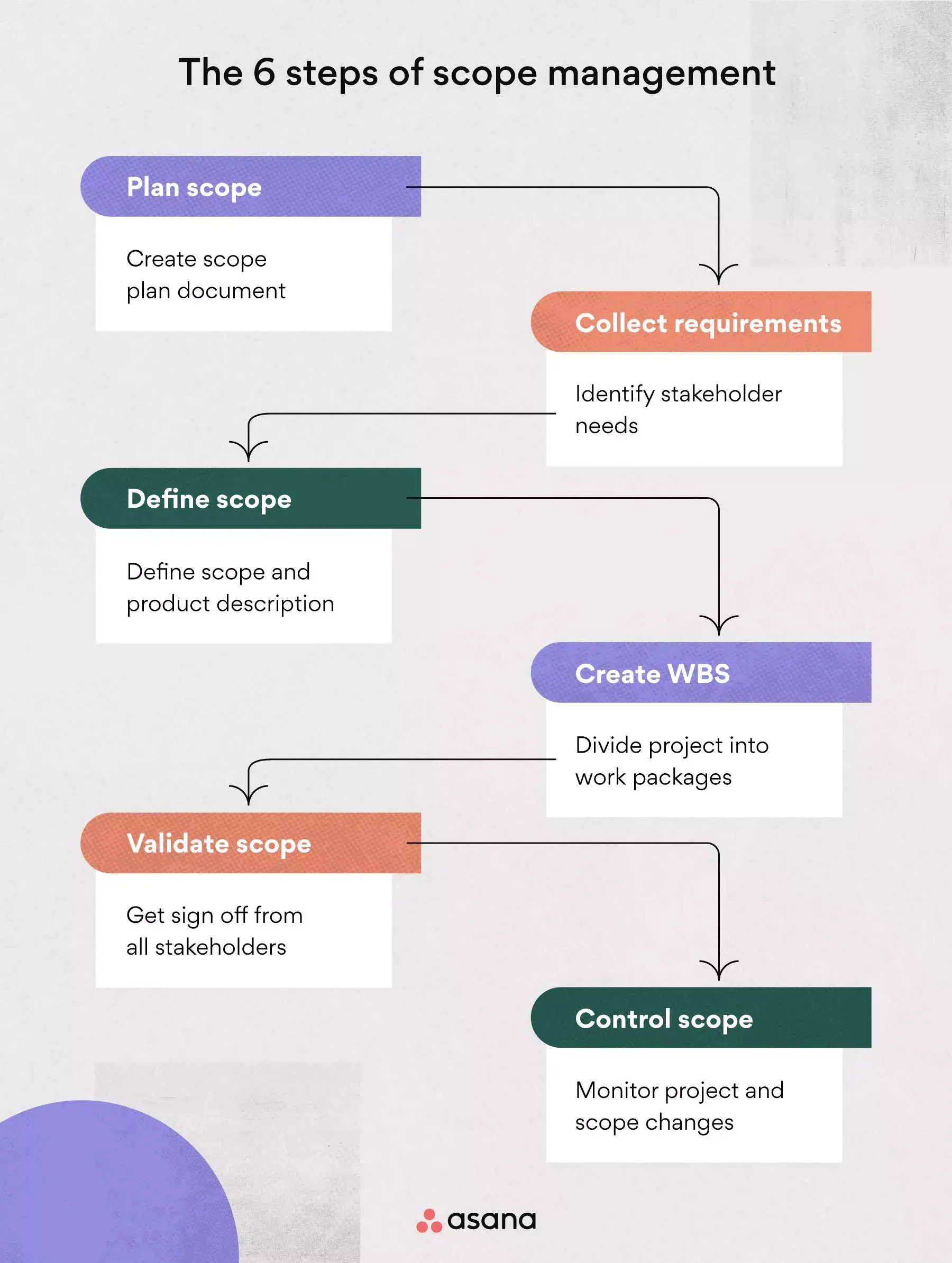
1. Create your scope plan
The first step in the planning process involves creating your scope plan document. This document should include your scope statement, a breakdown of project requirements, and any expected deliverables for the project.
Your scope plan document may also include a change control process , which is a process for change requests that can prevent scope creep. This is a document you can refer to in later stages of project planning. You may need this document for complex projects, projects where you think stakeholders will want many deliverables, or when there’s a lot of flux in what your deliverables might be.
Tips for creating a scope plan:
Incorporate expert judgment : To create your scope planning document, you need to consider all parts of the organizational process. Check in with cross-functional and executive stakeholders to ensure you have all of the information you need.
Hold scope kickoff meetings: Before you lock your scope document, make sure you have buy-in from all stakeholders. Share your scope plan document asynchronously , or host a kickoff meeting so that other managers and team members involved in the project can contribute to the initial scope statement.
2. Collect project requirements
In this step of the process, you’ll identify stakeholders’ needs so you can meet project objectives. Your goal should be to gather an in-depth list of requirements from stakeholders so that you can prevent scope changes down the line.
Tips for collecting project requirements:
Create a project charter: Create a project charter , or an elevator pitch, so stakeholders can clearly understand the project and ensure their expectations match the project's objectives.
Hold focus groups or workshops: Hold focus groups or workshops to give stakeholders a better understanding of your project. Communicating your project objectives to stakeholders is essential if you want them to buy into your project scope.
Develop prototypes: Develop a prototype of your project deliverable before presenting your project to stakeholders. This way, stakeholders can visualize the end product, voice their concerns, or list additional requirements early on.
3. Define scope
Once you’ve collected requirements from stakeholders, turn that information into a well-defined scope and a detailed product description. This document clarifies the expectations and deliverables for the project so that all team members know what they must accomplish.
Tips for defining scope:
Try product analysis: Before you can define your scope and write a detailed product description, you need to do an in-depth product analysis. Analyze the product you plan to create from the eyes of the customer or client in order to determine whether it will meet their expectations.
Generate alternatives: You’ll also want to generate alternatives in case your project encounters risks. For example, how will you meet stakeholder needs if you’re planning a new product launch and your launch date gets delayed?
Facilitate workshops: Host brainstorming workshops to clarify the scope of the project and to encourage collaboration among team members.
4. Create a work breakdown structure
A work breakdown structure (WBS) is a way to divide your project into levels of tasks. When you create a WBS, your team can clearly visualize each component of the project and assess what needs to be done.
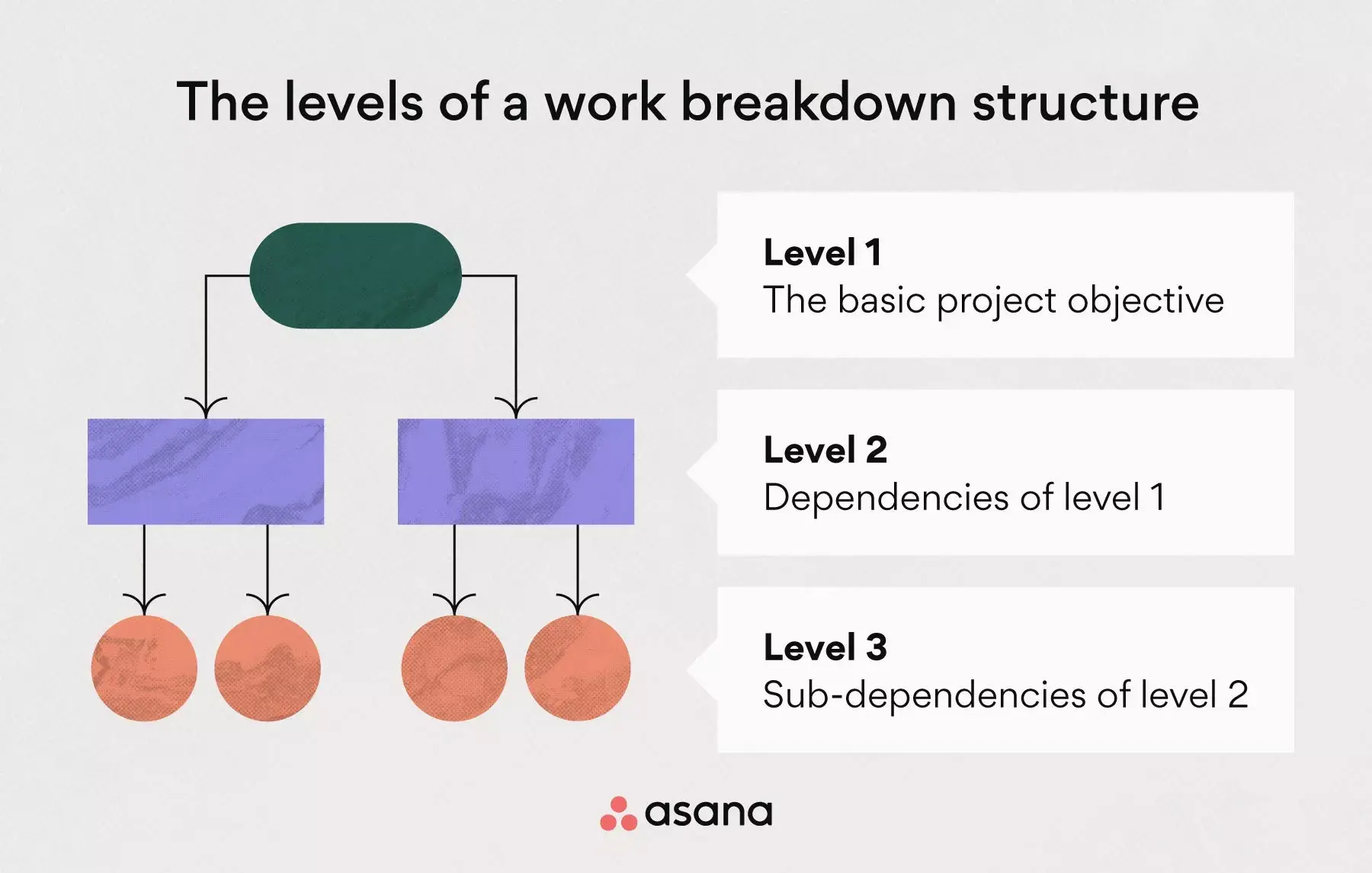
A work breakdown structure creates a hierarchical structure of tasks. From there, you can schedule, monitor, and control your project.
Tips for creating a WBS:
Decompose your project objective: A WBS decomposes, or breaks down, your project objective into dependencies and sub-dependencies. These smaller groups of tasks are often referred to as work packages. Once you break your tasks down, you have clear insight into everything your project needs, including the hours, equipment, tools, and expenses.
Automate workflows: Automating team member workflows can streamline coordination on projects and enhance project visibility. Using software to automate these workflows will also reduce manual information-gathering and duplicative work.
5. Validate scope
Validating your scope simply means getting sign-off from all stakeholders involved in the project. Make sure stakeholders clearly understand your project deliverables to avoid future scope creep. If possible, get feedback or advice on any changes and improvements.
Tips to validate scope:
Inspect your plan: Because validation is the final sign-off for your scope management plan, you’ll want to review and inspect it thoroughly. Team members can help you inspect the plan before sending it off to stakeholders, but stakeholders should also participate in a final inspection so that the plan gets as many eyes on it as possible.
6. Control scope
The last step in your scope management plan is scope control. As your project continues into the execution phase, monitor the status of the project and manage changes to the scope. The best way to streamline scope control is to use project management software. These tools can share feedback, files, and status updates on your project, so you’re aware of any scope changes in real time.
Tips to control scope:
Analyze variance: In this part of the scope management plan, assess how much variance in scope occurs. Analyzing the actual performance of your scope versus the planned performance will give you insight for future projects.
Refer to change control document: You created a change control process earlier in the planning phase. Remember to refer to this document so you can track the flow of information when it comes to project changes.
Tips for effective project scope management
Effective project scope management is crucial for the success of any project. It combines strategic planning and work management techniques to ensure that objectives are met efficiently.
Here are several tips to guide you in keeping your project on the right path from start to finish:
Clearly define the product and project scope. Begin with a precise definition of both the product scope—detailing the features and functions of the product or service being developed—and the project scope, which includes the work required to deliver the product. A clear distinction between these scopes helps prevent misunderstandings and scope creep.
Engage stakeholders early. Involve key project stakeholders early in the planning process. Their input can help refine the project scope and ensure it aligns with business objectives and stakeholder expectations.
Develop a detailed scope management plan. Create a comprehensive scope management plan that outlines how scope changes will be identified, evaluated, and implemented or rejected. This plan is your roadmap for navigating scope challenges.
Implement change control processes. Establish formal change control processes to manage requests for changes to the project scope efficiently. These processes help assess the impact of changes on the project timeline, budget, and resources.
Document everything. Keep detailed records of all project meetings, decisions, and changes related to the project scope. Documentation provides a clear reference point for all project participants and can be invaluable for resolving disputes and informing future projects.
Incorporating these tips into your project management practices can lead to more successful outcomes. Effective scope management is about balancing the detailed planning of product features and project work with the flexibility to adapt to changes.
Simplify your scope management with project management tools
A project scope management plan creates a clear structure for your team to follow during project execution. Scope management planning is easier if you use an online tool because you can share your plan with stakeholders, automate internal workflows, and easily break down project objectives into tasks. With project management software, you can streamline your processes and feel better prepared for what lies ahead.
Related resources

7 steps to crafting a winning event proposal (with template)

How Asana drives impactful product launches in 3 steps
How to streamline compliance management software with Asana

New site openings: How to reduce costs and delays
- Contact sales
Start free trial
Project Scope Statement: How to Write One With Examples

Still using emails, docs & spreadsheets to manage your projects? Revolutionize how you manage your projects with ProjectManager. Plan, track and report with automated tools.
The scope of a project is the sum of all the work that needs to be executed. A project scope statement helps project managers define the boundaries of what will and what won’t be done. But scope statements aren’t just about work management.
To write a project scope statement, you’ll need to understand the project goals, work breakdown structure and requirements, among other things. Then, once you’ve defined your project scope, you can create a scope document.
What Is a Project Scope Statement?
A scope statement is a document that defines all the elements of the project scope as well as assumptions, project requirements and acceptance criteria. Your project scope statement will act as the primary tool for stakeholders and teammates to reference and use as a guideline to accurately measure project success.
A project scope statement is part of the scope management plan , a larger document that contains all the strategies, rules and procedures to manage your project scope. In the same way, the scope management plan is an important component of your project plan.
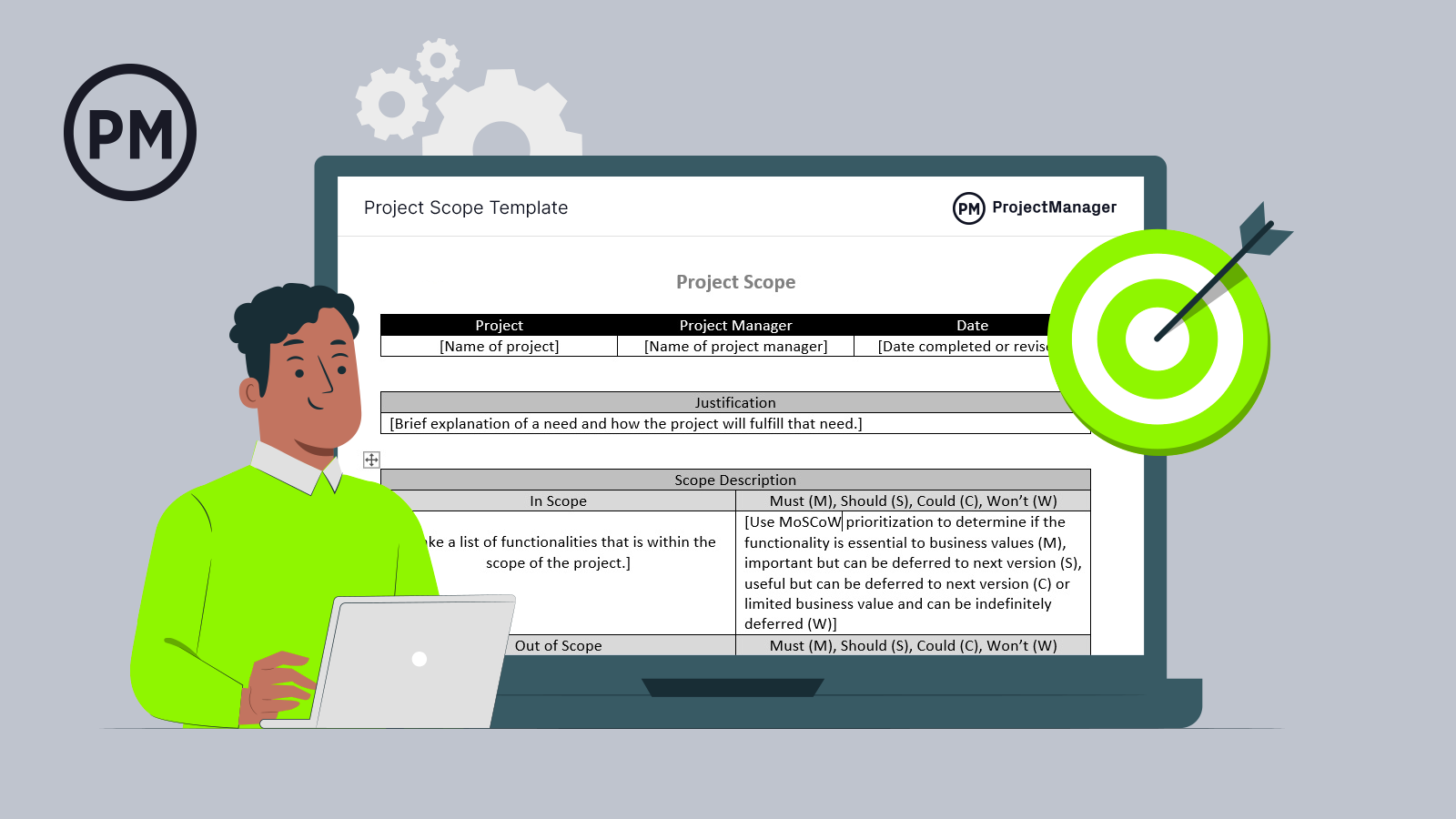
Get your free
Project Scope Template
Use this free Project Scope Template for Word to manage your projects better.
Project Scope Statement Sample
To better understand what the project scope statement is, we thought it’d be helpful to visualize it using our free project scope template for Word as a project scope statement example. As you can see, it has the basic project scoping information on top and then goes into a general justification for the project’s need and how it’ll fulfill that.
Then we get into the main part of the project scope statement, such as what will be in scope and out of scope for the project. This creates boundaries for the project and makes clear what is essential and must be prioritized.
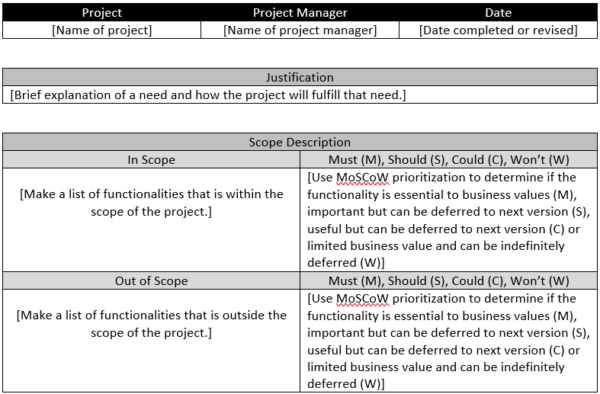
Now we get into explanations of the business objectives, such as targets that the project needs to hit in order to be successful, and the deliverables that’ll be produced over the life cycle of the project.
From there, you’ll describe project exclusions, issues of time, cost, scope, risk, resources and so on that could constrain it and whatever is assumed to be done in the project.
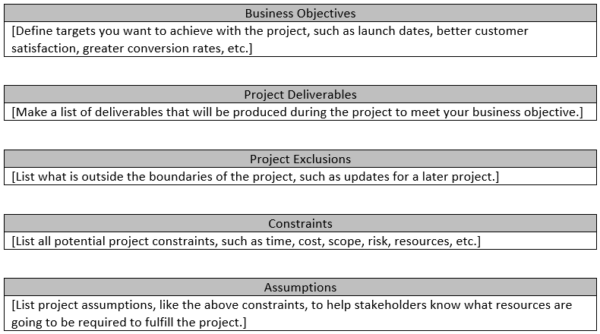
Finally, you’ll go into costs. The project scope statement is going to estimate the costs and list them all, including the estimated cost, the actual cost and the cost on completion of the project. Then you can show the variance, which is the difference between the estimated cost and the actual cost.

How to Write a Project Scope Statement
Now that we know what a project scope statement is, let’s learn how to write this important project management document. Similar to the five Ws of journalism—who, what, when, where, why—to properly outline your project scope statement, you must address these seven things:
1. Project Goals & Objectives
Project goals and objectives are what define the purpose of a project. Project objectives are the smaller steps that lead to the project goals, which are broader. Start your project scope document by explaining them. These goals and objectives should be documented in a project charter , too.

2. Project Requirements
Project managers and stakeholders must reach an agreement about the project scope and other project requirements such as the expected quality, risk, benefits and cost, among others.
3. Project Scope Description
It might sound easy enough, but this is the most important step. Here is where you’ll define your project scope, which is all the work that needs to be done to complete the project. Here are some simple steps to help you define the project scope.
- Use a work breakdown structure to visualize all your project tasks, deliverables, and milestones.
- List what’s within the scope of your project, and what’s out of scope. Everything that’s not included in the project scope is known as project exclusions.
- Identify project constraints, which are all the limitations such as time or cost.
- Create a scope baseline to compare your actual progress to the planned project scope.
Project exclusions and constraints are essential because they help establish boundaries for the project to exist. They also manage your stakeholders’ expectations/input and give your team members some creative limitations to work within.
4. Project Exclusions
While it’s imperative that you define the boundaries around what the project includes from the outset, it’s also extremely important that you list what this project doesn’t include. For example:
- Application updates that are planned for a later project and are intentionally not included in this project
- Restricted or rescheduled customer access to certain support lines/product features
5. Project Constraints
Project constraints are what make managing projects such a puzzle to solve. The top three constraints to managing any project are typically time, money and scope, known as the triple constraint of project management. They’re interconnected, meaning that if you pull one lever on ‘scope,’ another lever on ‘money’ or ‘time’ will also move.
But there are additional project constraints that can crop up at any time, including risk, resources, organization, method, customers and more. List all the constraints you foresee in your project, so you can try to have solutions in place ready to launch when needed.
6. Project Assumptions
Your project assumptions typically revolve around the very things that end up being constraints, including time, money and scope. For example, it’s in this section of your project scope document, “the front-end development team will be available during this project time period,” or, “the customer support team will receive new product training by x time.” It’s important to list these out as this won’t only tell key stakeholders what your primary resource needs are to make the project go, but it also gives you fast insight as to where your biggest risk factors lie.
7. Project Deliverables
List out the deliverables your team members need to produce in order to meet business objectives. This can include the product itself, instruction and installation manuals, marketing materials, press releases, advertising campaigns and more.
Your project scope statement outline helps act as a marker as you build out your full scope statement. Because while predicting the future of the project is impossible at such a high level, this is the first step to getting your project as close to the outcome as possible. By starting with the seven key statements above, you can get a head start on a successful project.
Gantt charts are the workhorses of scope management. However, most Gantt chart software is woefully limited in terms of its functionality. ProjectManager has dynamic online Gantt charts that do the regular organizing, prioritizing and linking dependencies and adding milestones. But unlike other tools, you can filter for the critical path. When you set the baseline, you’re able to compare your actual progress to what you had planned. There’s no better way to monitor project scope.
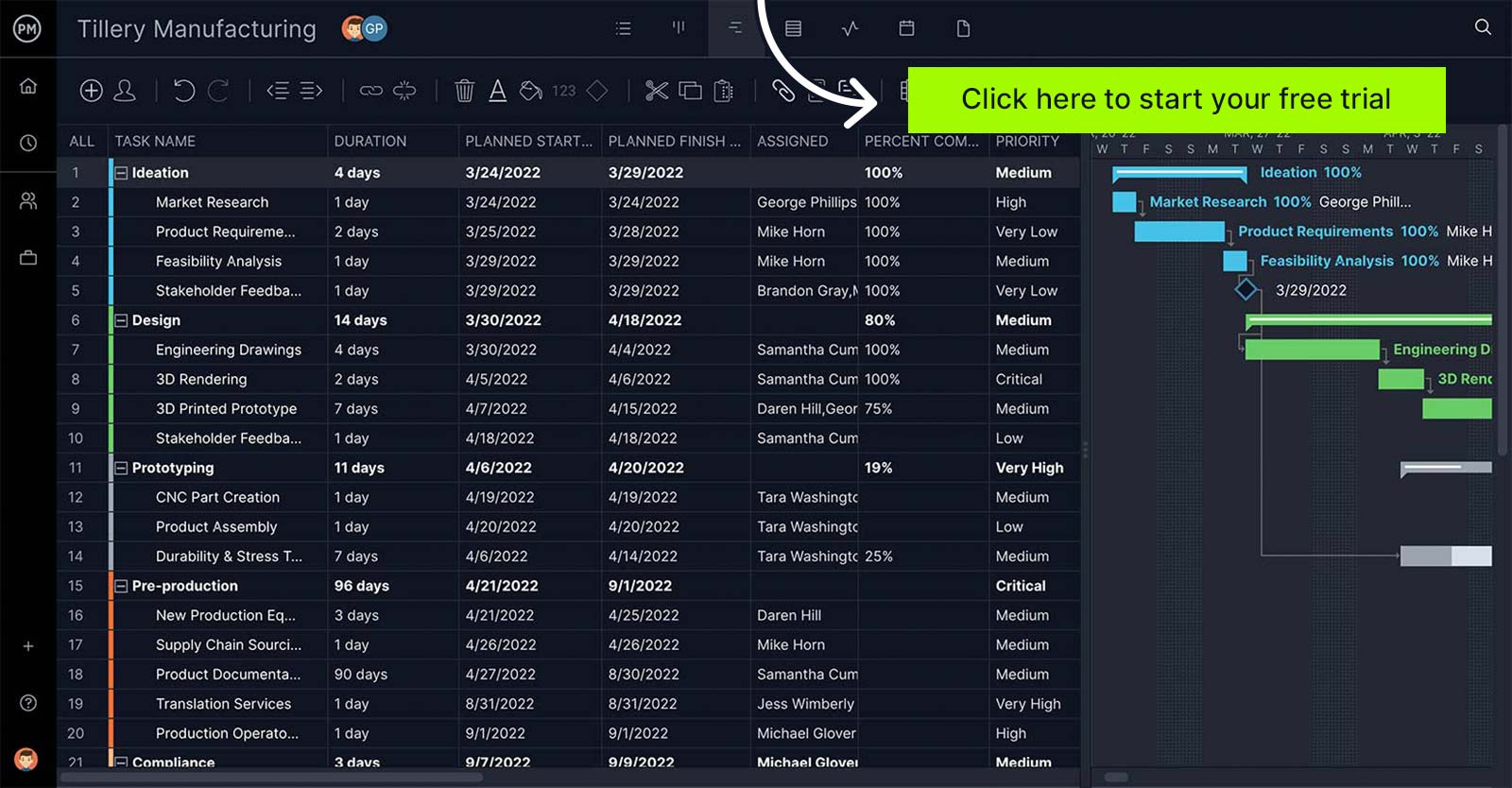
Project Scope Statement Examples
Now let’s review two simple project scope statement examples to better understand how a scope statement can be used in different industries.
Construction Project Scope Statement Example
Defining the scope of a project is one of the most important steps in the project planning process . In construction, defining the scope helps construction project owners, contractors and subcontractors not only reach an agreement on what the construction project will look like but also create an accurate project cost estimate based on the work, materials, equipment and labor that’ll be required.
- Project Goals & Objectives: Build a residential construction project, an apartment complex that will generate revenue for the construction firm.
- Project Requirements: Architects, engineers and construction project managers will work on the construction design to determine the specifications and requirements for the project. These include quality standards for construction materials and safety requirements, among others. To have a clear understanding of what these project requirements will look like, they’ll need to create a set of construction drawings and construction documents such as blueprints, a bill of quantities and computer-assisted designs.
- Project Scope Description: Once there’s a design for the building, the project scope can be defined by using a work breakdown structure that’ll allow the construction management team to zoom into the types of tasks that will need to be executed, such as masonry, plumbing, electrical and other types of construction activities.
- Project Exclusions: One of the most important things when writing a scope statement is to state what activities won’t be executed, known as project exclusions. Clearly explaining this helps avoid misunderstandings down the road.
- Project Constraints: In project management, there are three traditional project constraints; time, scope and cost. However, there are even more project constraints that can affect a construction project, such as resources, quality and risk. For any construction project, there will be constraints that need to be factored in during the project planning phase such as environmental concerns, local regulations and building codes.
- Project Assumptions: In any project, there are assumptions that subject matter experts will draw before the construction phase begins. These are usually things beyond the control of the construction management team, such as weather conditions, availability of suppliers and the ability of the team to complete work within the planned time frame. These assumptions will be proven true or false once the work begins.
- Project Deliverables: As previously stated, the construction project involves different types of work such as HVAC, electrical work, woodwork and masonry, among others. Each of these construction crews or subcontractors will be responsible for producing many project deliverables throughout the construction phase.
Manufacturing Project Scope Statement Example
Manufacturing projects generally involve the production of physical products. This takes a series of steps needed to transform raw materials into finished goods. Here’s a simple scope statement example for manufacturing.
- Project Goals & Objectives: Create a finished product based on market research and the strategic planning of the company.
- Project Requirements: There will be internal and external requirements for the development and manufacturing of your product. In terms of internal requirements, think about the concerns of your company stakeholders who will want low production costs, high profit margins and the shortest time possible to get a return on their investment. In terms of external requirements, consider the competition in your market and the preferences of your target customers such as the quality, price and features they expect from your product.
- Project Scope Description: The project scope in this case will summarize the different activities that are part of the production cycle. This includes the product development process, the procurement and transportation of raw materials, parts and components from suppliers to the production line, the assembling process, quality control procedures and the distribution channels that’ll be utilized to bring the product to the market.
- Project Exclusions: It’s important to explain to your stakeholders exactly what features will be included in your product as well as the quality standards that will be followed. Product documentation such as a bill of materials is ideal to define your project exclusions.
- Project Constraints: There will be project constraints specific to manufacturing such as limited production capacity, resource availability, customer demand and machinery maintenance.
- Project Assumptions: Brainstorm with different departments involved with the product, such as marketing, sales, production and maintenance to draft as many project assumptions as you can get. The more cross-functional insights you can get, the better. It’s important to be ready to face multiple scenarios. A good way to do so is to use linear programming models to simulate different levels of production and customer demand.
- Project Deliverables: The deliverables will be all the different product development documents that’ll guide the production process , the product prototype and finally the final version of the product that’ll be launched to the market.
Project Scope Statement vs. Scope of Work
There are a few things that project scope statements typically get confused with, including your scope of work . They may sound like similar project scoping documents, but here are the primary differences between these two.
Your scope of work is an agreement of work, typically between consultant and client, that details the agreement of work to be performed, including, but not limited to:
- Deliverables/products/results
- Project timeline
- Project milestones
- Reports to catalog project progress
While your scope of work can be time-consuming to write, it outlines the project itself and not necessarily the plan that’s to follow. The project scope statement, in turn, fulfills that role by detailing and mapping out exactly what to expect with the project plan and the project itself.
Scope Statement vs. Scope Management Plan
They might sound similar, and the outcome of the project may be similar, but a project scope statement is different from your project scope management plan . A project scope management plan is what follows the project scope statement, detailing the scope management process from the start to the finish of your project life cycle.
Additionally, it helps define the work that must be done over the course of the project, and it controls and monitors those processes. It also documents and tracks phases to avoid scope creep and assists with project closing, including an audit of deliverables and assessing the project outcome for success factors.
Your scope statement isn’t nearly as involved—it’s just the umbrella over your project scope management plan, acting as a rubric for stakeholders and team members to follow.
Tips to Write a Project Scope Statement
Here are the best practices to consider as you write your project scope statement:
- Avoid using jargon-heavy language. You’ll be talking to multiple people across multiple departments and specializations, so keep the language consistent and clear.
- Keep it short. Since this is a project document that’s seeking stakeholder buy-in, there will likely be plenty of editing to be done before it’s finalized, and it’ll need to be a quick reference guide for later. So, keep it simple and save the verbiage for your full project plan.
- Stay away from sweeping statements. You don’t want to over-commit your resources to the project before it even kicks off.
- What are the long-term business benefits?
- What does it provide our customers that do not already exist?
- Is this better than what we currently offer on the market?
ProjectManager & Project Scope Management
Major project rollouts can be demanding on both your time and energy. Don’t let it overwhelm you before kick-off. For starters, you can use our Gantt chart software to create a WBS and get a visual on deliverables, as well as the tasks needed to complete before submitting your project scope statement.
From there, you can try ProjectManager and use our task management features to get all the necessary tasks organized, prioritized and sorted by project phase. You can even ask other people for input: team members can comment directly on the tasks so communication stays organized and to the point.
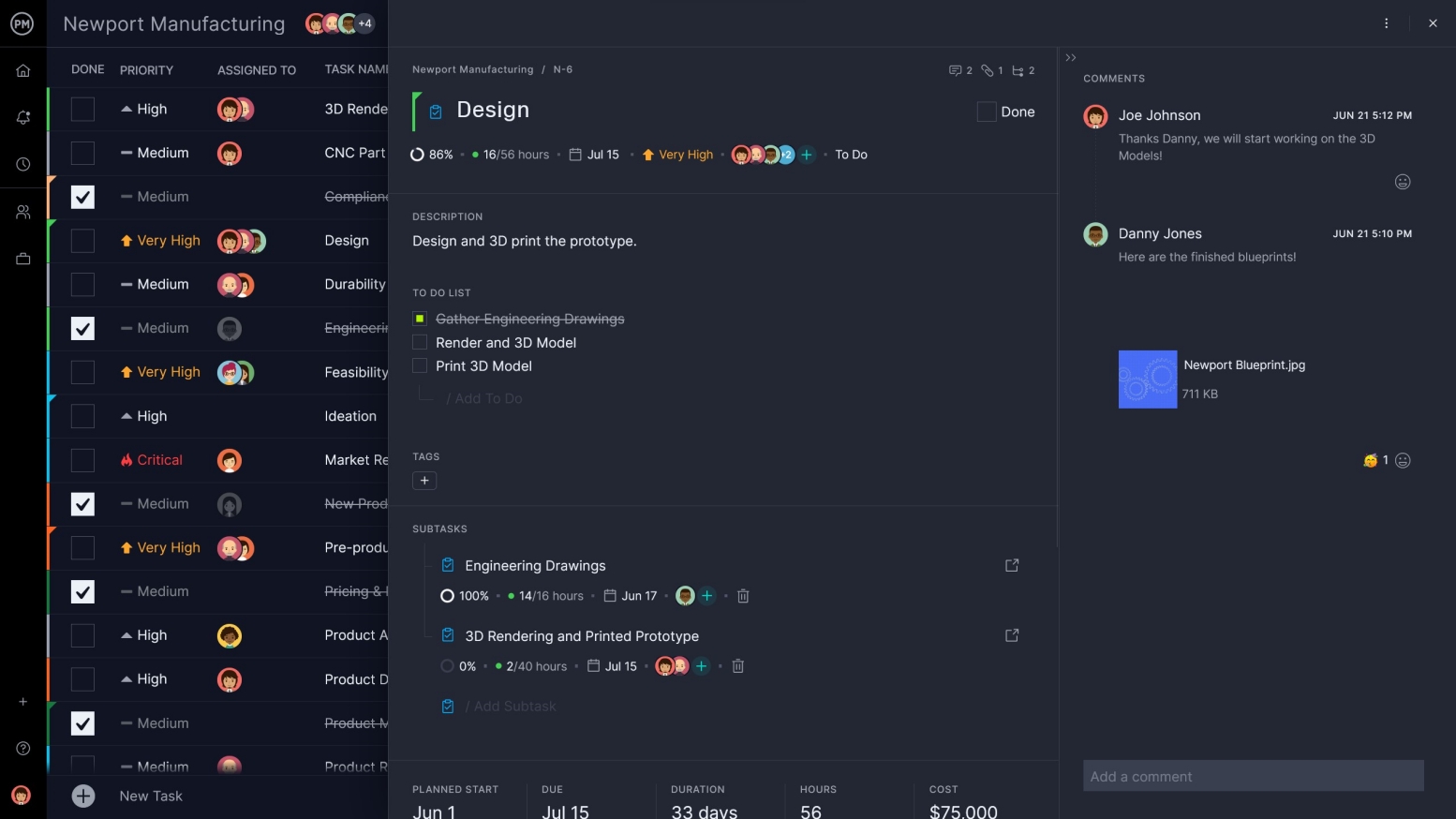
Keep tabs on your resources, tasks, deliverables and more so you can keep your project on track. With ProjectManager, you can practice mapping out your project timeline by using our Gantt chart, listing out deliverables using our task list or kanban tool and inviting team members to review the timeline before submitting the scope statement to key stakeholders. Start your free 30-day trial today.

Deliver your projects on time and on budget
Start planning your projects.
- Announcements
- Brainstorming
- Development
- HR Planning
- Infographics
- IT & Operations
- Marketing & Sales
- Meeting & Visual Collaboration
- Product Management
- Production & Manufacturing
- Project Management
- Remote Working
- Research & Analysis
- Software Teams
- Strategy & Planning
- Template Roundup
- Uncategorized
What is Project Scope Management | Complete Guide with Steps, Templates, and Tips
Updated on: 10 August 2022
If you are a project manager and you have found yourself trapped in a ‘bite off more than you can chew’ kind of situation, it means that you have failed to effectively define the project scope at the planning stage. When a project runs with an undefined scope, you have no idea about the amount of work that has to be completed to achieve its objectives. Consequently, you might fail to complete the project in time.
In this post, we will be looking at what project scope management is and its importance in project planning .
What Is Project Scope Management?
Project scope management encompasses the amount of work – i.e. objectives, tasks, deliverables, and deadlines – fulfilled to complete an assignment. It is important to define the project scope at the beginning of the project to ensure that your team sticks to the plan and avoids the need to perform any unnecessary work to complete the project.
Furthermore, in practical scenarios, it is common for projects to have slight course diversions along the way due to modifications in project objectives. A clearly defined project scope will help you navigate through and accommodate such changes effectively.
Why Is Project Scope Management Important?
Defining the project scope is all about efficient project management. A project manager’s job demands attention to detail and managing the expectations of multiple stakeholders .
A properly defined project scope helps project managers stay on top of things when it comes to task tracking and meeting deadlines throughout the project life cycle . When a project is properly tracked, meeting expectations becomes less complicated.
Moreover, project scope management provides a clear understanding of the amount of effort required to fulfil the tasks involved by distinguishing between what and what not to do. It will also have certain controls over changes in project objectives, consequently helping the team to stay on course without pivoting.
Determining the project scope also helps avoid some of the common project management pitfalls such as,
- Falling behind deadlines
- Exceeding the approved budget
- Constant requirement changes
- Mid-cycle project direction changes
More importantly, a well-defined project scope will be the compass that directs you throughout the assignment to meet the expected final outcome.
Project Scope Management Process
Let’s try to understand each step of the project scope management process.
Identifying the Project Requirements
You can’t start a journey without knowing the destination. It is essential to clearly identify what a particular project aims to accomplish, before embarking on it. Conduct discussions with clients and other external stakeholders to determine the exact requirements of the project. This includes project objectives, deliverables , and the budget. You can list out the deliverables in a work breakdown structure (WBS) according to a hierarchy based on the priority of each requirement.
Sometimes clients tend to have higher expectations without a sufficient budgetary allocation to fulfil them. Prepare a shareable document of all requirements and ensure that all parties involved understand what the project sets out to achieve.
Plan Scope Management
Now that you have identified the requirements, the second step is to prepare a document to plan the project scope. The structure of this document should include,
- The project scope statement
- List of project requirement s
- Expected deliverables
- Mapped out process to control changes of the project course
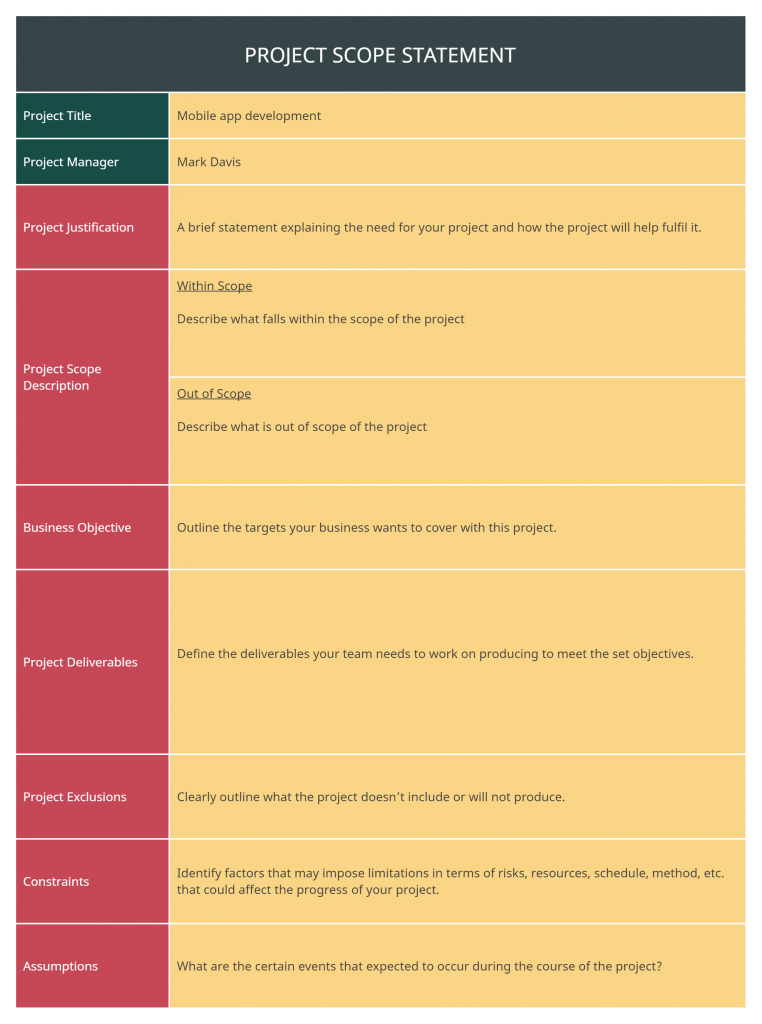
The project scope plan will evaluate and define the project scope, and you can refer to this document at later stages when clarification is needed.
Define the project scope
This is the most important step in determining the project scope. In this step, you need to have the requirements in detail in order to structure the project scope. The scope should contain the ultimate aim of the project.
It is also important to also note down what is not included within the project scope for further clarity. This will ensure that your team is only working on the previously identified requirements . Anything outside the purview will not be considered as part of the project tasks.
Work Structure
The work structure of the project includes a task breakdown and the owner of each task. You can use one of Creately’s multiple kanban board templates to do the task breakdown , assign owners to each, and set deadlines. This will help you to keep a good track of your progress.
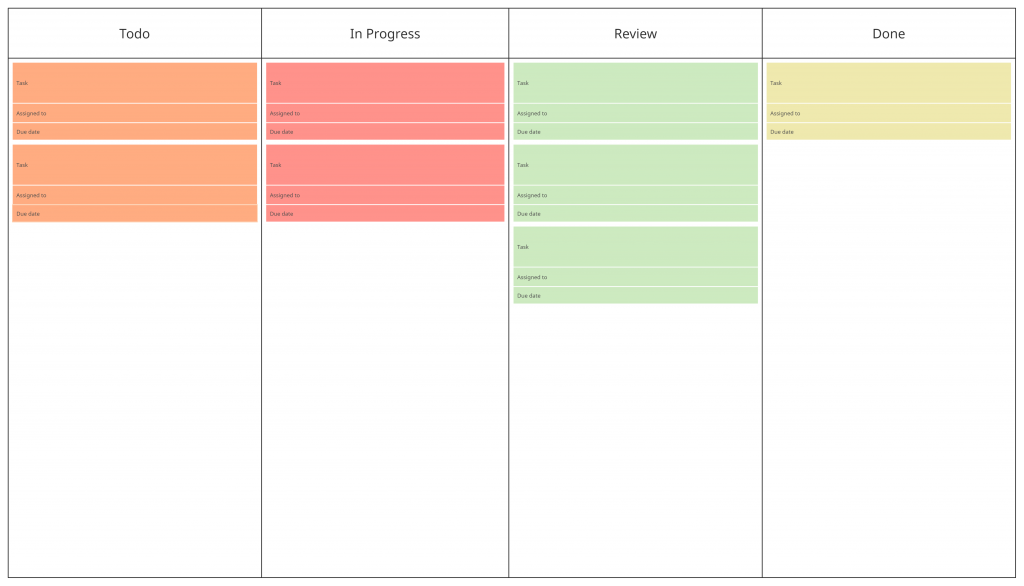
Validate Scope
Once you have developed the scope, it is important to share it with external stakeholders as well as your team to get the necessary approvals before proceeding. Make sure everyone is on the same page when it comes to requirements, deliverables, and deadlines so that bottlenecks can be minimized. A project manager is the bridge that connects the project team and the clients, so it is your responsibility to make sure that everyone involved clearly understands what the mission is.
Control Scope
Once the project work begins, the project manager should constantly evaluate its progress and make sure that the team does not deviate from the original plan. Controlling scope is part and parcel of project tracking. Furthermore, when clients suggest changes to the original requirements, the project manager should ensure that such changes do not pivot from the project scope identified at the beginning.
Don’t Bite off More Than You Can Chew
An overwhelming load of work is never pleasant. So when you are assigned to a project, always make sure to clearly define the project scope before commencing work. Get your team on board with the defined scope and make them understand why it is important not to deviate from it. This will ultimately help you to become a successful project manager and make sure that projects are completed within deadlines, without exceeding budgets.
Join over thousands of organizations that use Creately to brainstorm, plan, analyze, and execute their projects successfully.

More Related Articles
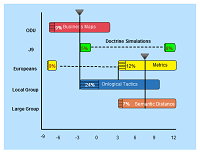
Leave a comment Cancel reply
Please enter an answer in digits: five + 11 =
Download our all-new eBook for tips on 50 powerful Business Diagrams for Strategic Planning.
Popular Insights:
Best Project Management Software
Mind Mapping Software
Guide to Project Scope in Business
Reviewed by
Share this Article:
Our content and product recommendations are editorially independent. We may make money when you click links to our partners. Learn more in our Editorial & Advertising Policy .

According to the Project Management Institute, adversarial scope changes are the biggest cause of project failure. Project scope in business is a crucial component of project management, and when not clearly defined, it can lead to serious schedule and budget challenges.
Read on to learn more about what project scope in business is and best practices for writing and managing one.
Featured Partners
{{ POSITION }}. {{ TITLE }}
What is Project Scope and Why is It Important?
The scope of a project defines what is part of the project and what is not. Project scope definition is a concept that is not clearly captured, explaining why it’s problematic for many teams. It represents the sum of things that a project has to take care of, including its purpose, objective, and how to achieve them. Scope defines the project boundaries.
Since a project is a temporary endeavor with a start and end date, poorly defined boundaries results in moving goal posts that make it harder to manage projects.
Here’s a real-life example.
When the team behind the Royal Adelaide Hospital construction closed the project, they realized it was 18 months behind schedule and AU$640 million over budget. The total cost reached AU$2.3 billion, making the hospital the most expensive building in Australia. The primary reason why the project ended this way was because of project scope changes that included requests to add features such as service robots that deliver linen and digital tags that track medical equipment and patients.
A loosely defined project scope increases the risk of the project going behind schedule or over budget or both. To avoid these, project managers need to write a good project scope statement.
Read also: What is Scope Creep in Project Management?
What is Project Scope Statement?
A project scope statement outlines the entire project. It includes a description of the scope, deliverables and their features, justification of why the sponsors initiated the project, exclusions, constraints, and assumptions.
Overall scope description: The scope description is a high-level statement that lists what is within the scope of the project. It is an important step that helps establish the boundaries for the project.
Read More: Project Statement of Work (SoW)
Project deliverables: The project team lists the deliverables that the project aims to produce in order to meet the business objective or client need. It includes the key components that constitute a successful project. This section identifies the key features and can include instruction manuals and other marketing documents or materials.
Project justification: Project justification, sometimes called business case, provides a better understanding of the scope statement. It explains the need for the project and how the end result solves that need.
Read More: How to Effectively Participate in Meetings
Project exclusions: At the start of the project, not all information is available or known, so it may include uncertainties. Just as it is important to identify the boundaries and state what the project includes, it is also as important to list out what is not included in the project to dispel any wrong assumptions.
Read More: Service-Level Agreement in Project Management
Project constraints: All projects have time, budget, and scope constraints all interconnecting at some level. But other constraints can exist for projects, such as resources, methods, or customers. The project team needs to list all constraints so they are ready to build solutions when needed.
Assumptions: This section lists the assumptions the project team made in defining the scope of the project. The team should list all those conditions and the impact those assumptions have on the project if it turns out they were inaccurate.
Read More: What is Project Management? Definition, Types, and Examples
Project Scope Example
Project managers do not know all project boundaries at the time of writing the scope statement. But that’s okay, as long as they remember that all uncertainties are risks that can be come project schedule or project cost issues. The following is a simple project scope example.

Project Scope Management
Writing a good project scope statement limits the risks and unpleasant possibilities coming from poorly defined project boundaries. A clear scope statement makes it easy for stakeholders to accept them, put the project team in sync, and prevent unauthorized tasks from creeping in. Project scope management is a knowledge area that professional project managers study and practice. The PMBOK identifies six processes:
- Planning scope management: planning the process and creating the plan
- Collecting requirements: defining and documenting stakeholder needs and other requirements that the project needs to meet
- Defining scope: compiling the requirements into a scope statement
- Creating WBS: subdividing project deliverables into smaller work packages and tasks
- Validating scope: formalizing the acceptance of the deliverables
- Controlling scope: monitoring and managing changes into the project scope
Read also : Managing Scope During Project Life Cycle Phases
Best Practices for Project Scope Writing and Management
Every project includes uncertainties. Project managers have no way to include each one of them as they write their project scope. But there are three ways to deal with uncertainties and risks:
- Accept the risk and take on additional time, cost, or scope.
- Transfer the risk to a third party and let them assume partly or wholly the cost.
- Mitigate the risk by performing actions that will reduce the risk of the uncertainty.
In writing project statements, here are some of the best practices to consider while writing your project scope:
- Avoid jargons and keep the language consistent and clear for all project stakeholders and participants.
- Keep it short and simple, and save the details for the full project plan .
- Avoid sweeping statements so as not to overcommit and underdeliver.
Watch out for scope creep. Instead of making corrective but costly actions later in the project, consider the following straightforward steps as preventive measures:
- Limit timelines and rein in schedules from the start to ensure a smaller and more manageable scope.
- Identify what’s out of scope and define both sides of the boundary with project sponsors.
- Build contingencies such as a strong contingency budget to limit the negative impact of scope creep.
Read More: What Is Traceability and How Does It Impact Project Management?
Join our newsletter
Subscribe to Project Management Insider for best practices, reviews and resources.
{{ TITLE }}
You should also read.

What is Smartsheet? 2024 Beginner’s Guide

Technical Project Manager (TPM) vs Project Manager (PM)

DACI Decision-Making Framework: Everything You Need to Know

Get the Newsletter
You might also like.

Risk Breakdown Structure (RBS) in Project Management Explained
AI in Project Management: Uses, Impacts, & 2024 Trends
Waterfall Model Methodology: Everything You Need to Know

IMAGES
VIDEO
COMMENTS
Project scope management is essential for project success. Learn how to define, plan, and control project scope effectively with our comprehensive guide. Discover the key concepts and tools for managing project scope, from scope statement to scope verification and change control.
Get a free project scope management plan to optimize your team’s project planning. Includes a scope management template and step-by-step guide.
A project scope statement helps project managers define the boundaries of what will and what won’t be done. But scope statements aren’t just about work management. To write a project scope statement, you’ll need to understand the project goals, work breakdown structure and requirements, among other things.
Project scope management encompasses the amount of work – i.e. objectives, tasks, deliverables, and deadlines – fulfilled to complete an assignment. It is important to define the project scope at the beginning of the project to ensure that your team sticks to the plan and avoids the need to perform any unnecessary work to complete the project.
In project management speak, your project scope describes the specific objectives, deliverables, costs, constraints, and assumptions associated with a project. You achieve your project scope by consulting with all relevant stakeholders in a project.
Project scope in business is a crucial component of project management, and when not clearly defined, it can lead to serious schedule and budget challenges. Read on to learn more about what project scope in business is and best practices for writing and managing one.